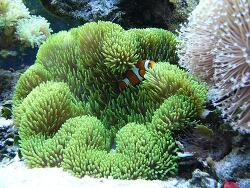Info
Stichodactyla gigantea, in German giant anemone, is a sea anemone from the tropical coral reefs of the Red Sea as well as the Indo-Pacific. Despite its name it is not the biggest anemone, that is Stichodactyla mertensii. Distribution: Indo-Pacific; in shallow water in calm environments, on sandy bottoms or on platform reefs of lagoons.
In Stichodactyla gigantea, unlike Stichodactyla haddoni, the color shading is absent and the tentacles, about 1cm long, are dense only at the edge and become less towards the center.Stichodactyla gigantea hardly nettles, but sticks very strongly! The Giant Anemone is an omnivore in the truest sense of the word, on its menu are also careless or sick fish and crustaceans that come too close to it.
Here applies as with all sea anemones: If the foot is not injured, and the water values are right, it is good to acclimate. Since it becomes very large, the basin should be accordingly dimensioned, besides, sea anemones in freshly furnished aquariums have nothing to look for.
It needs stable water values for the care.
When buying please always make sure that the foot is unharmed, the animal does not look limp and the mouth is closed.
The following sea anemonefishes are known partners from nature:
Amphiprion clarkii, Amphiprion ocellaris, Amphiprion percula, Amphiprion perideraion, Amphiprion akindynos, Amphiprion bicinctus, Amphiprion rubrocinctus.
It is possible that also other sea anemonefishes
Synonymised names
Actinia amethystina Quoy & Gaimard, 1833 · unaccepted
Actinia brevitentacula Quoy & Gaimard · unaccepted
Actinia gigantea (Forskål, 1775) · unaccepted
Actinia Gigas Bruguière, 1798 · unaccepted > junior subjective synonym
Actinia gigas [Renier], [1804] · unaccepted > unavailable name
Actinia gygas Bruguière, 1789 · unaccepted > junior subjective synonym
Actinia parvitentaculata Quoy & Gaimard, 1833 · unaccepted
Discosoma gigantea · unaccepted
Discosoma giganteum · unaccepted
Discosoma kenti Haddon & Shackleton, 1893 · unaccepted
Isacmaea gigantea Hemprich & Ehrenberg · unaccepted
Polyparium ambulans Korotneff, 1886 · unaccepted
Priapus giganteus Forsskål, 1775 · unaccepted (original binomen)
Radianthus parvitentaculata (Quoy & Gaimard, 1833) · unaccepted
Radianthus parvitentaculatus (Quoy & Gaimard, 1833) · unaccepted
Stichodactyla kenti (Haddon & Shackleton, 1893) · unaccepted
Stoichactis (Priapus) giganteum (Forsskål, 1775) · unaccepted
Stoichactis gigantea (Forsskål, 1775) · unaccepted
Stoichactis giganteum (Forsskål, 1775) · unaccepted
Stoichactis giganteus (Forsskål, 1775) · unaccepted
Stoichactis gigantium · unaccepted
Stoichactis intermedia Lager, 1911 · unaccepted
Stoichactis kenti Haddon & Shackleton, 1893 · unaccepted







 Koelle-Zoo-Ludwigshafen
Koelle-Zoo-Ludwigshafen














